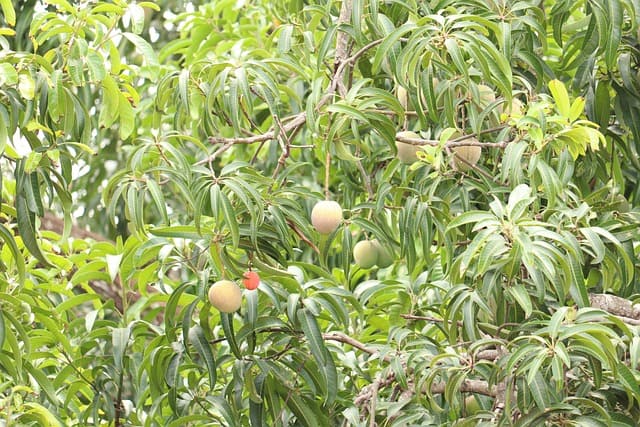Mango trees are a popular choice for gardeners and homeowners who want to enjoy delicious, juicy fruit right from their backyard. However, yellowing leaves on mango trees can be a cause for concern.
Mango tree leaves turning yellow can be a sign of several issues, including watering problems, nutrient deficiencies, pests, and diseases.
Understanding mango trees is important to identify the causes of yellowing leaves. Mango trees require warm, humid climates with plenty of sunshine and well-draining soil. They are susceptible to several pests and diseases that can affect their growth and fruit production.
Additionally, they require regular maintenance and care to stay healthy and productive.
There are several reasons why mango tree leaves may turn yellow, including watering issues, nutrient deficiencies, diseases and pests, and environmental factors. Proper watering, fertilization, and pest control can help prevent yellowing leaves and keep mango trees healthy.
Regular plant health maintenance is also crucial to ensure optimal fruit production.
Key Takeaways
- Mango trees require warm, humid climates and well-draining soil to thrive.
- Yellowing leaves on mango trees can be caused by various issues, including watering problems, nutrient deficiencies, pests, and diseases.
- Proper plant health maintenance, including watering, fertilization, and pest control, is essential to prevent yellowing leaves and ensure optimal fruit production.
More on this category:
Understanding Mango Trees
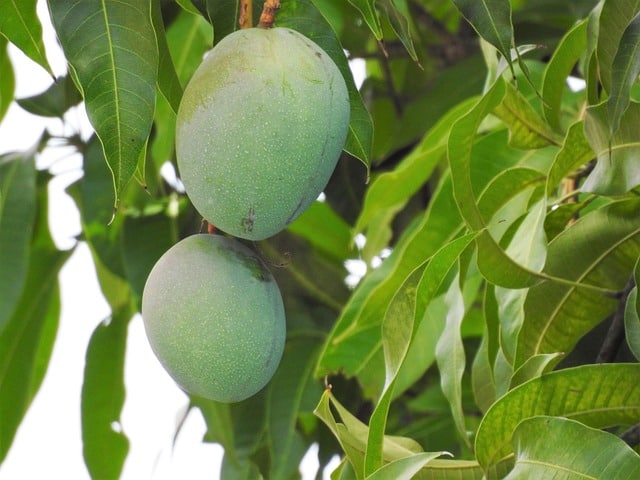
Mango trees are tropical trees that require full sun to grow and thrive. They are known for their sweet, juicy fruits that are enjoyed by people all over the world. Mango trees can grow up to 100 feet tall, but most mature trees are around 30 to 40 feet tall. Young trees and seedlings require more attention and care than mature trees.
Mango trees are evergreen, which means they keep their leaves all year round. The leaves of a healthy mango tree are dark green and glossy. However, if the leaves start turning yellow, it could be a sign of a problem.
There are several reasons why mango tree leaves turn yellow. One of the most common causes is overwatering. Mango trees do not like wet feet, and too much water can lead to root rot, which can cause the leaves to turn yellow. On the other hand, if the tree is not getting enough water, the leaves can also turn yellow and dry out.
Another reason why mango tree leaves turn yellow is due to lack of sunlight. Mango trees require a minimum of 6 hours of direct sunlight per day to grow properly. If the tree is not getting enough light, the leaves will become yellow and spindly.
Mango trees also require proper fertilization to thrive. If the tree is not getting the right nutrients, the leaves can turn yellow. It is important to use a fertilizer that is specifically formulated for mango trees.
Mango Tree Leaves Turning Yellow – 4 Common Problems
Yellow leaves are a common problem experienced by mango tree growers. There are several reasons why mango tree leaves turn yellow. In this section, we will explore some of the common causes of yellowing leaves on mango trees.
1. Overwatering
Overwatering is one of the most common causes of yellow leaves on mango trees. High rainfall or adding too much water yourself through irrigation or your garden hose can cause the leaves to turn yellow.
Overwatering leads to a lack of oxygen in the soil, which can damage the roots and cause the leaves to wilt and turn yellow. If the soil is too wet, the roots can also become susceptible to fungal infections, which can further damage the tree.
2. Underwatering
Underwatering can also cause yellowing of mango tree leaves. If the tree is not getting enough water, the leaves will start to wilt and turn yellow. This is because the tree is not able to take up enough water to support the leaves.
Underwatering can also lead to stress on the tree, which can further weaken the tree and make it more susceptible to disease.
3. Nutrient Deficiencies
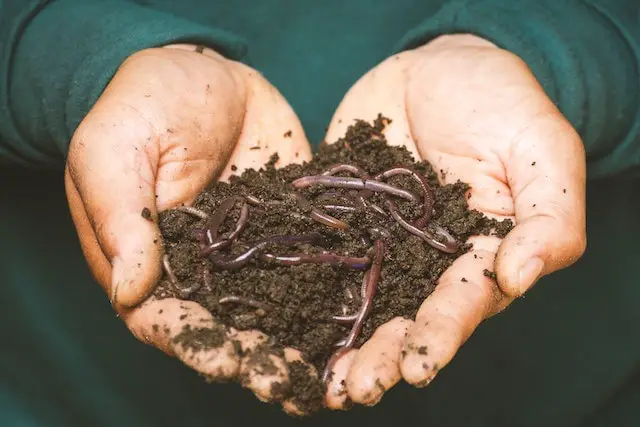
Mango trees need a balanced supply of nutrients to grow and produce healthy leaves. If the tree is not getting enough of certain nutrients, it can cause the leaves to turn yellow.
Nitrogen deficiency is a common cause of yellowing leaves on mango trees. This nutrient is essential for the growth of new leaves, and a lack of it can cause the leaves to turn yellow and fall off. Other nutrient deficiencies, such as iron or magnesium, can also cause yellowing of the leaves.
4. Pests and Diseases
Yellowing of mango tree leaves can also be caused by pests and diseases. Common pests that can damage mango trees include spider mites, mealybugs, and scale insects. These pests can damage the leaves and cause them to turn yellow.
Diseases such as powdery mildew and anthracnose can also cause yellowing of the leaves. These diseases are caused by fungi and can be spread by wind or rain.
Watering Issues
Mango trees require consistent and appropriate watering to thrive. Overwatering and underwatering can both cause yellowing of leaves.
1. Overwatering
Overwatering is a common cause of yellowing leaves on mango trees. High rainfall or adding too much water yourself through irrigation or your garden hose can cause the leaves to turn yellow.
This year, if there has been almost triple the amount of rain that you normally get over summer, it may have washed out valuable nitrogen from the soil.
To avoid overwatering, it is important to check the soil moisture level before watering. You can do this by sticking your finger into the soil about 2 inches deep. If the soil feels moist, do not water the tree. Mango trees prefer a wet and dry cycle, so allowing the soil to dry out slightly before watering again is beneficial.
2. Underwatering
Underwatering is another cause of yellowing leaves on mango trees. If the tree is not getting enough water, the leaves will start to wilt and turn yellow. This can occur if the tree is not receiving enough water through irrigation or rainfall.
To avoid underwatering, it is important to water the tree deeply and regularly. A good rule of thumb is to water the tree once a week, giving it enough water to soak the soil to a depth of at least 2 inches.
3. Proper Watering

Proper watering is crucial for the health of mango trees. The tree should be watered deeply and regularly, but not too frequently. It is important to allow the soil to dry out slightly before watering again.
Mango trees prefer a well-draining soil that is moist but not waterlogged. To ensure proper drainage, the tree should be planted in a location with good soil and proper drainage.
Nutrient Deficiencies
Yellow leaves on mango trees can also be a result of nutrient deficiencies. Mango trees require a balance of nutrients to thrive, and when one or more of these nutrients are lacking, the leaves can turn yellow. Here are some common nutrient deficiencies that can cause yellow leaves on mango trees:
- Nitrogen Deficiency: Nitrogen is an essential nutrient for plant growth and development, and a lack of nitrogen can cause leaves to turn yellow. Symptoms of nitrogen deficiency include yellowing leaves starting from the tips and moving towards the stem, stunted growth, and reduced fruit production. To remedy this, fertilizers with high nitrogen content can be used.
- Phosphorus Deficiency: Phosphorus is important for root development and fruit production. A lack of phosphorus can cause leaves to turn yellow and fall off prematurely. Symptoms of phosphorus deficiency include yellowing leaves with a reddish or purplish tint. To correct this, phosphorus-rich fertilizers can be used.
- Potassium Deficiency: Potassium is essential for plant growth, water regulation, and stress tolerance. A lack of potassium can cause leaves to turn yellow and develop brown spots. Symptoms of potassium deficiency include yellowing leaves starting from the edges and moving towards the center. To remedy this, fertilizers with high potassium content can be used.
- Magnesium Deficiency: Magnesium is important for photosynthesis and chlorophyll production. A lack of magnesium can cause leaves to turn yellow, with the veins remaining green. Symptoms of magnesium deficiency include yellowing leaves starting from the edges and moving towards the center. To correct this, Epsom salt or magnesium sulfate can be added to the soil.
- Iron Deficiency: Iron is essential for chlorophyll production, and a lack of iron can cause leaves to turn yellow. Symptoms of iron deficiency include yellowing leaves with green veins. To correct this, iron chelates or iron-rich fertilizers can be used.
In addition to using fertilizers, adding compost and organic matter to the soil can also help improve nutrient availability and prevent nutrient deficiencies. It is important to note that over-fertilizing can also cause nutrient imbalances and lead to yellow leaves, so it is important to follow recommended application rates and schedules.
Diseases and Pests
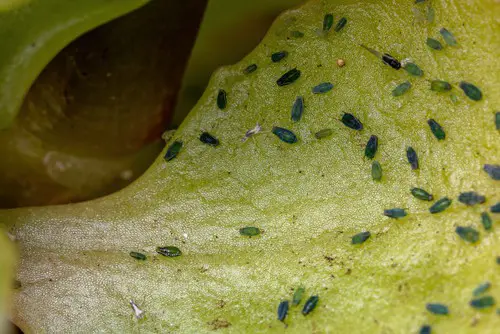
Mango trees are susceptible to various diseases and pests that can cause yellowing of leaves. Some of the common diseases and pests that affect mango trees are discussed below.
1. Anthracnose
Anthracnose is a fungal disease that affects mango trees. It can cause yellowing of leaves, defoliation, and fruit rot. The disease is caused by Colletotrichum gloeosporioides, which can infect all parts of the mango tree, including leaves, flowers, and fruits.
The fungus can survive on infected plant debris and can be spread by wind, water, and insects. To control anthracnose, infected plant debris should be removed, and fungicides such as sulfur or copper-based fungicides should be applied.
2. Chlorosis
Chlorosis is a condition that occurs when the mango tree does not receive sufficient nutrients, especially iron. It can cause yellowing of leaves, stunted growth, and poor fruit production. To correct chlorosis, fertilizer containing iron should be applied to the soil. In severe cases, foliar sprays containing iron can also be used.
3. Spider Mites
Spider mites are tiny pests that can cause yellowing of leaves on mango trees. They feed on the sap of the leaves, causing them to turn yellow and eventually fall off. The pests can be controlled by using insecticidal soap or oil sprays.
4. Root Rot
Root rot is a fungal disease that affects the roots of mango trees. It can cause the leaves to turn yellow and wilt. The disease is caused by soil-borne fungi that thrive in wet soil conditions. To prevent root rot, the mango tree should be planted in well-draining soil, and watering should be done only when necessary.
5. Aphids
Aphids are small insects that can cause yellowing of leaves on mango trees. They feed on the sap of the leaves, causing them to turn yellow and curl. The pests can be controlled by using insecticidal soap or oil sprays.
6. Susceptible Parts
The leaves, flowers, and fruits of mango trees are susceptible to fungal diseases and pests. It is important to monitor these parts of the tree for any signs of yellowing or damage and take appropriate measures to control the problem.
Regular pruning and removal of infected plant debris can also help prevent the spread of diseases and pests.
Environmental Factors

Yellowing of mango tree leaves can be caused by a variety of environmental factors. Understanding these factors can help you prevent yellowing and ensure the healthy growth of your mango tree.
1. Sunlight
Mango trees require plenty of sunlight to thrive. Inadequate sunlight can cause yellowing of leaves, especially in the lower and inner parts of the tree. Direct sunlight is essential for the tree to produce fruit. If the tree is not receiving enough sunlight, it may produce fewer fruits, and the leaves may turn yellow and drop off.
2. Winter Months
During the winter months, mango trees may experience yellowing of leaves due to the lower temperatures and reduced sunlight. This is a natural process and is not a cause for concern. However, if the yellowing persists beyond the winter months, it may be due to other factors.
3. Humidity
Mango trees prefer a warm and humid climate. Low humidity levels can cause the leaves to dry out and turn yellow. In contrast, high humidity levels can lead to fungal growth and yellowing of leaves. It is important to maintain the right humidity levels for the tree to grow healthy.
3. Drought
Drought can cause the leaves of mango trees to turn yellow and fall off. During drought conditions, the tree may not receive enough water to support its growth, leading to yellowing of leaves. It is important to water the tree regularly, especially during dry periods.
4. Strong Winds
Strong winds can damage the leaves of mango trees, causing them to turn yellow and fall off. The wind can also cause the tree to lose its moisture, leading to yellowing of leaves. It is important to protect the tree from strong winds by planting it in a sheltered location or using windbreaks.
5. Sunburn
Mango trees can experience sunburn if they are exposed to direct sunlight for extended periods. Sunburn can cause yellowing of leaves and damage to the tree. It is important to protect the tree from direct sunlight by providing shade or using a reflective material to deflect the sun’s rays.
Plant Health Maintenance
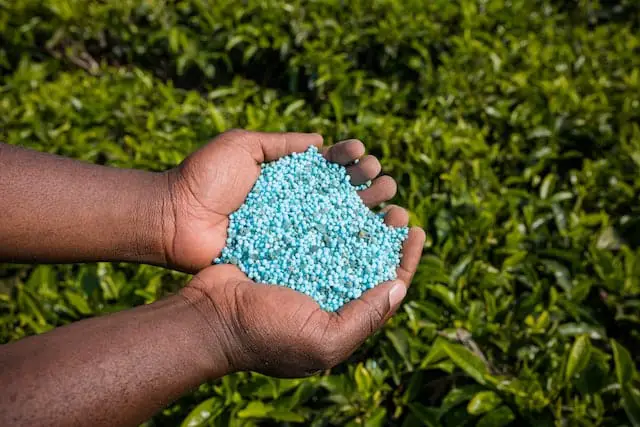
To maintain healthy mango trees and prevent yellowing of leaves, there are several plant health maintenance practices that should be followed.
1. Consistent Watering and Drainage
Mango trees require consistent watering to maintain healthy growth. Proper drainage is also important to prevent waterlogging, which can lead to root rot and yellowing of leaves. It is recommended to water the tree deeply once a week, ensuring that the soil is moist but not waterlogged.
2. Mulching
Mulching is an effective way to retain moisture in the soil and prevent weed growth. It also provides organic matter that can improve soil fertility. It is recommended to apply a layer of mulch around the base of the tree, taking care not to cover the trunk.
3. Pruning
Pruning is an important maintenance practice that promotes vegetative growth, flowering, and fruiting. It is recommended to prune the tree annually to remove dead, diseased, or damaged branches. Pruning also helps to maintain the shape and size of the tree.
4. Fertilizer Application
Mango trees require regular fertilizer application to maintain healthy growth and prevent yellowing of leaves. It is recommended to apply fertilizer every three months during the growing season.
Organic fertilizers such as cow manure and coffee grounds are effective in improving soil fertility. Neem oil and copper fungicide can also be used to prevent pest and disease infestation.
5. Moisture Stress and Defoliation
Moisture stress and defoliation are common causes of yellowing of mango tree leaves. It is important to ensure that the tree is not subjected to prolonged dry conditions. If the tree is experiencing moisture stress, it is recommended to water it deeply and regularly.
Defoliation can also be prevented by ensuring that the tree is not subjected to extreme weather conditions or pest infestation.
By following these plant health maintenance practices, mango trees can be kept healthy and free from yellowing of leaves.
Role in Fruit Production
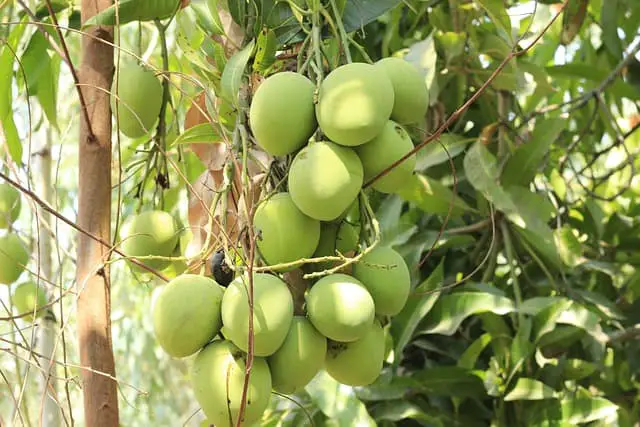
Mango tree leaves play a crucial role in fruit production. They are responsible for photosynthesis, which is the process of converting sunlight into energy that the tree uses to produce fruit. Healthy leaves are essential for the tree to produce high-quality fruit.
Yellowing leaves can negatively affect fruit production. When the leaves turn yellow, it can be an indication that the tree is not getting enough nutrients or water. This can cause the fruit to be smaller, less flavorful, and less juicy.
In addition to affecting fruit quality, yellowing leaves can also lead to a reduction in fruit production. This is because the tree needs a certain number of healthy leaves to produce fruit. If too many leaves turn yellow and fall off, the tree may not have enough energy to produce a full crop of fruit.
It is important to take steps to prevent yellowing leaves and promote healthy leaf growth. This can include providing the tree with the right amount of water and nutrients, as well as protecting it from pests and diseases that can kill the leaves.
Frequently Asked Questions
What are the common causes of mango tree leaves turning yellow?
Yellow leaves on mango trees can be caused by several factors, including overwatering, lack of nutrients, pest infestations, and diseases.
Overwatering is a common cause of yellow leaves on mango trees. High rainfall or adding too much water yourself through irrigation or your garden hose can cause the leaves to turn yellow.
Lack of nutrients is another common cause of yellow leaves on mango trees. Mango trees need nutrients to grow faster, so a lack of good fertilizers can cause problems.
How can I prevent my mango tree leaves from turning yellow?
To prevent yellowing and ensure healthy growth, it’s important to provide the mango tree with proper care. Mango trees require well-draining soil, so make sure the soil is not waterlogged.
Water the tree only when the top inch of soil is dry. Use organic and natural fertilizers such as pelleted chicken manure and fish emulsion to provide the tree with the necessary nutrients. Regular pruning and pest control can also help prevent yellowing of leaves.
What is the best way to treat mango tree leaves that are turning yellow?
The best way to treat mango tree leaves that are turning yellow is to identify the underlying cause. If the cause is overwatering, reduce the amount of water you give to the tree.
If the cause is lack of nutrients, use organic and natural fertilizers to provide the tree with the necessary nutrients. If the cause is a pest infestation, use appropriate pesticides to control the pests. If the cause is a disease, consult a professional arborist for treatment options.
Can overwatering cause mango tree leaves to turn yellow?
Yes, overwatering is a common cause of yellow leaves on mango trees. High rainfall or adding too much water yourself through irrigation or your garden hose can cause the leaves to turn yellow.
Are yellow spots on mango leaves a sign of disease?
Yellow spots on mango leaves can be a sign of disease. Some common diseases that cause yellow spots on mango leaves include anthracnose, powdery mildew, and bacterial black spot.
If you notice yellow spots on your mango tree leaves, consult a professional arborist for treatment options.
How can I tell if my mango tree leaves are turning yellow due to a nutrient deficiency?
If your mango tree leaves are turning yellow due to a nutrient deficiency, you may notice other symptoms such as stunted growth, smaller and fewer fruits, and brown spots on the leaves.
To confirm if the yellowing is due to a nutrient deficiency, you can take a soil test or consult a professional arborist for diagnosis.

Hey, I’m Lisa and I’ve been an avid gardener for over 30 years. I love writing, talking and living in the garden! Feel free to connect with me on my socials below

